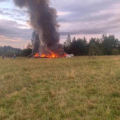ArcelorMittal is on the hunt for supplies of US liquefied natural gas in what would be its first LNG deal for its European steelmaking operations.
With the search in its early days, no decision has been made on the length or structure of a contract to supply LNG, but industrial peers of the world’s second-largest steelmaker have signed agreements for about 20 years.
The decision to seek a deal follows disruption of the European gas market because of the war in Ukraine as concerns persist over high and unstable prices and pipeline supplies, said five people familiar with the matter.
LNG has become more attractive as an alternative energy source, particularly from the US, after Russia slashed pipeline supplies following its invasion of Ukraine.
Industries, especially in Germany, have spent decades building an industrial sector reliant on cheap Russian pipeline gas but were hit by Moscow’s cuts and explosions last year that demolished parts of the Nord Stream pipeline.
A deal would also follow ArcelorMittal’s joint venture with Nippon Steel in India when it signed a five-year LNG agreement with France’s TotalEnergies in 2021.
It would make it the third European industrial company to sign a US LNG agreement after petrochemical groups Ineos’ and BASF’s deals with producers Sempra Infrastructure and Cheniere Energy, respectively.
Ineos’ deal with Sempra runs for 20 years from 2027, while BASF’s deal runs from mid-2026 through to 2043.
Other US LNG producers include Energy Transfer, NextDecade and Commonwealth LNG.
Luxembourg-based ArcelorMittal needs vast amounts of power for its furnaces. Its steelmaking processes also require natural gas.
Gas is increasingly considered a better option as a power source because it emits less CO? than coal, which would help the company decarbonise over the longer term, the people familiar with the matter said.
The group has a target of reducing its CO? emissions relative to output by 25 per cent globally and in its European operations by 35 per cent by 2030.
It also wants to use more gas as it moves from traditional blast furnaces to less carbon-intensive electric arc furnaces.
Ineos, whose deal with Sempra was signed in December last year, is also looking to provide its LNG to other groups in need of alternative gas supplies.
With fluctuating gas demand, Ineos aims to sell on any surpluses as part of a strategy to make the most of its LNG shipments.
David Bucknall, chief executive of Ineos Energy, the petrochemical group’s energy arm, said European industries have been hamstrung by higher energy costs compared with the US.
“US businesses have a distinct advantage in that energy costs are low,” he said. “You are starting to see a disadvantage in Europe?.?.?.?to really access that [cheaper US energy] you have to go to the source.”
He added that it would take companies with size and global operations to consider delving into LNG.
“I think you have to be quite large and ambitious?.?.?.?if you are not global, if you don’t have the [gas] demand across the globe and options across the globe, it is difficult to step into LNG.”
While prices have receded this year, they are still high by historical standards and volatility has remained.
Although Europe can source LNG from other parts of the world such as Qatar, companies such as Ineos, BASF and ArcelorMittal consider the US a better alternative supplier as contracts there are usually more flexible.
They allow companies options to resell to other parties or divert cargoes to their operations in other parts of the world where the gas is needed.
“We’re likely to see more deals” between European industrial companies and US LNG producers, said Mauro Chavez, head of European gas and LNG markets at consultancy Wood Mackenzie.
ArcelorMittal declined to comment.



